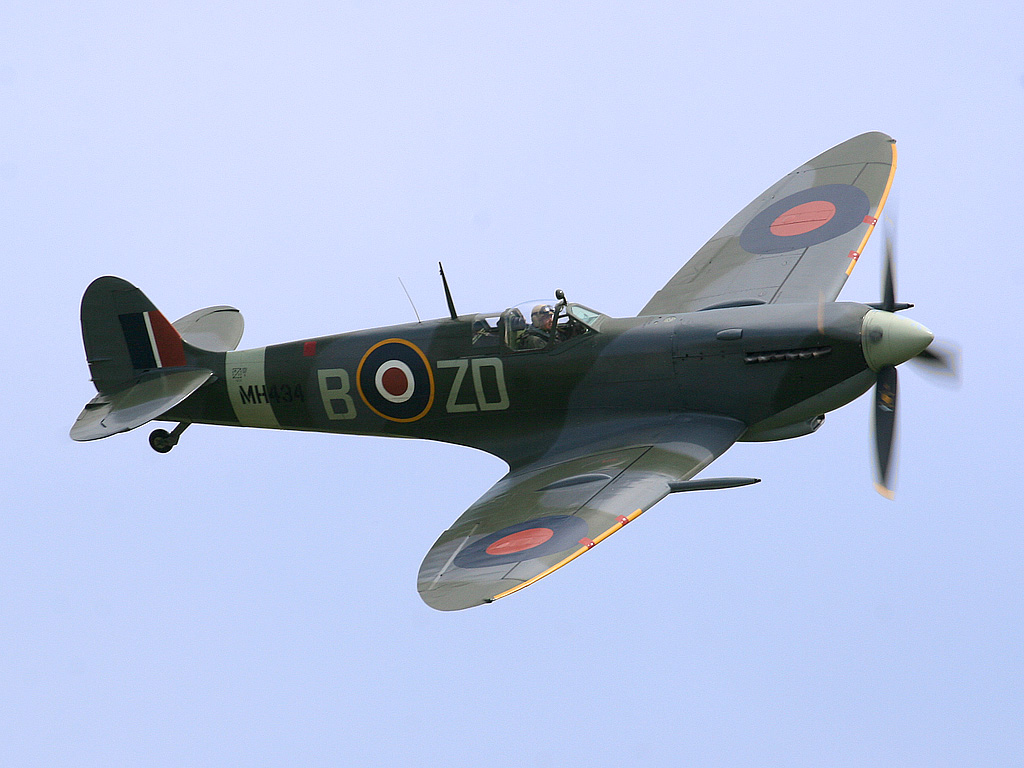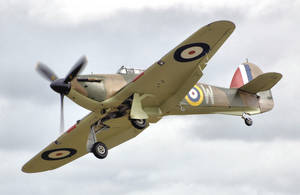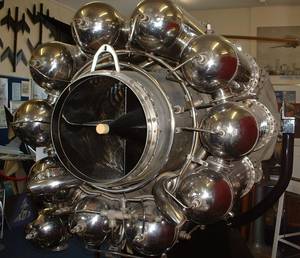World War Two and the Jet Engine
Interview with
Ben - The sudden diversification in the way aeroplanes were being used after the First World War forced engine designers to factor in commercial considerations such as reliability and fuel efficiency...
Peter Halford - It's still the case, to a great extent, with the military, obviously what they're interested in is performance and reliability and all of that, and efficiency and ease of maintenance and so forth is not quite so important. When you come to commercial aircraft then the efficiency and the economics is very, very important. You want to be able to fly your aeroplane as much as possible and make as much revenue as possible so you want it to be very reliable. So, those kinds of things were coming into play as well during the 1920s and 1930s. Of course, precautions are always being taken, defences are really important things, and engines are part of all of that, so things were being developed. But also, of course these engines would be used in other aeroplanes as well.
Ben - So, driven by both commercial interests and the ever-present threat of another war, engines of all types were increasing in power and efficiency...
Peter Halford - This is not so much moving on in time, but development of the engine which has its pistons and cylinders arranged on the outside. This time, not rotating around the central shaft but fixed, driving onto the central shaft along the radii, so it's called a radial engine. It's a Bristol Hercules engine. It would've been used for many different applications, but also in military aircraft and the one we're looking at here could develop over 1,600 horsepower. So we've gone from 5 horsepower to 1,600 horsepower and this is a 1939 engine.
 Ben - But it wasn't just the engine design that was marching apace. Almost as soon as man left the ground, engineers were seeking a way to make piloting aircraft easier - by automating as much of the process as possible. These autopilot systems developed rapidly, were demonstrated extensively in the 1930s, and considered important enough to make the national newsreels...
Ben - But it wasn't just the engine design that was marching apace. Almost as soon as man left the ground, engineers were seeking a way to make piloting aircraft easier - by automating as much of the process as possible. These autopilot systems developed rapidly, were demonstrated extensively in the 1930s, and considered important enough to make the national newsreels...
Ben - Aeroplanes and their engines evolved between the wars, refining existing designs into the engines we would come to rely upon in the battles for air supremacy in the Second World War...
Peter Halford - The basics are still the same. This is a piston engine, so with pistons moving up and down in cylinders. The whole thing has been made much more compact, the materials have advanced. There's a lot more alloys, aluminium and so on in an engine like this. It's using the V formation so that you get more cylinders but still in a compact engine. The one we're looking at at the moment is a Rolls Royce Kestrel engine and it led almost directly to possibly the most famous aeroengine that's ever been, the Rolls Royce Merlin.
Ben - An iconic and extremely important engine, the Rolls Royce Merlin first flew in 1933, and went on to power some of the best known planes of the 2nd world war...
Peter Halford - It developed from other engines, a very successful formula, and what happened was that it was continuous development. So, it started off before the Second World War and gradually developed and developed, became more and more efficient, more and more powerful. It was also very versatile in as much as it was small enough and powerful enough to drive fighters such as the Hurricane, the Spitfire, and the American Mustang, but also, it could be used in multiples to drive such large aeroplanes as the Lancaster Bomber. So, it was a very, very versatile engine and it was really the continuous development of it which led to its success.
The materials were developing, particularly alloys, alloys of aluminium and of steel, and so on, things that will withstand the pressures, the temperatures, the vibrations, the rotation and all of that. And when we think back to the earlier engines, it's actually a relatively short time for this development to have taken place. And, notwithstanding the changes in electronics and computers and things in recent times, this is one of the fastest developments of technology that ever been.
 Ben - And it became a decisive development, as the Hurricanes and Spitfires that the Merlin engine powered were deployed in the battle of Britain, regarded as one of the turning points of the 2nd world war. The aeroplanes, and their RAF pilots, garnered new respect...
Ben - And it became a decisive development, as the Hurricanes and Spitfires that the Merlin engine powered were deployed in the battle of Britain, regarded as one of the turning points of the 2nd world war. The aeroplanes, and their RAF pilots, garnered new respect...
Winston Churchill, 1940
Ben - But despite Prime Minister Winston Churchill's memorable speech, and the victory at the battle of Britain, designers of aero engines didn't rest on their laurels. Piston engines were reaching their limits...
Peter Halford - The Second World War was really the first time when major use of air power happened. Not only in fighting with small fighters such as Spitfires and Mustangs, and Messerschmitts and so on, but also, aerial bombing - a tremendous amount of that. So we have very, very large aeroplanes like the one we're standing right close to me now, the famous Lancaster Bomber. So then you're requiring very, very large aeroplanes, very powerful for very, very large payloads, and as with any other conflict, it's a race between one power and the other so, as one set of aircraft from one air force was developing then the others had to develop, and so on. A lot of it was in place beforehand and it was just that continuous and rapid development that we mentioned with the Merlin, for instance, which took place throughout those very brief, but very, very significant few years. This brought us eventually to having really enormous engines such as the Napier Sabre engine which really represents the top of the chain as far as piston engine is concerned - the optimum. So, it could then develop up to 3,000 horsepower, but then you get a very, very large heavy engine weighing itself about a ton and with a large surface area and so on. So after that, you're going to compromise the power to weight ratio so much that you can't go much further which is where you need another form of power entirely.
 Ben - So with an imperative to find new ways to increase the power to weight ratio, a new type of engine had to be designed...
Ben - So with an imperative to find new ways to increase the power to weight ratio, a new type of engine had to be designed...
Peter Halford - Well, there'd already been something there. In fact, there had been an idea for thousands of years that the Greeks had known about and this is jet propulsion. In fact, the first successful jet aeroplane flew in 1910. When you consider that the Wright Brothers only flew the first successful powered aeroplane in the 1903 that is not very long afterwards. This was called the Coanda 1910, imaginatively, by Henri Coanda. He used a piston engine to compress the gas and he unfortunately had the Coanda effect named after him because he discovered it by mistake when the hot gases from his engine flowed along the fabric sides of his aeroplane and set it on fire. Luckily for him, he jumped off and was safe, but of course, nobody would back him any further so his idea was lost for a time. However, it was re-taken up and successful Coanda jet aeroplanes were flying in the 1940s and afterwards. However, in the interim, another method had been discovered and developed particularly here in this country by Frank Whittle and over in Germany by an engineer called Hans von Ohain and that was the gas turbine. And when you combine a gas turbine with a jet, you have the gas turbine jet propeller, and that's where things moved on to, and that's where we are today.
Ben - Looking from the outside, the jet engine appears to be a completely different design to the airscrew propellers that we were used to. But what about the physics behind it?
Peter - Well, the basic physics is just the same because you need something going in one direction, so an action, and a reaction in the other direction. In many ways, it's very similar because you would use rotating blades. But this time, you put the blades inside the engine rather than on the outside. So, an airscrew propeller is on the outside and a gas turbine jet propeller has the blades on the inside. You then compress the gas, the air that is, and you mix it with a fuel, and that becomes a highly volatile compressed gas. You set fire to it, it goes bang and expands, and blows out the other end, creating the force that you need to push it along. The simple explanation of that is that you suck the air in, you squeeze it down, you make it go bang and it blows out of the back. So it is suck, squeeze, bang, blow - really simple. But of course, the difficult part is the engineering and the engineering depends very much on the materials because now, you're going to have something that's going to not only withstand those heats but also enormous pressures, lots of rotation and so on. So, developing those materials or finding suitable materials was one of the most difficult parts of the exercise.
Ben - Peter Halford from the Imperial War Museum at Duxford.
creative commons attribution licence by
Fight2FlyPhoto, and captioned: "This is the sound of a Supermarine Spitfire Mk Vc with a Rolls-Royce Merline followed by a Spitfire Mk. IXe with a Packard Merlin."










Comments
Add a comment